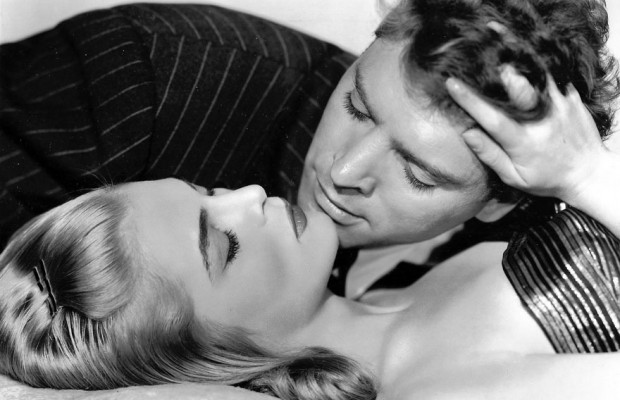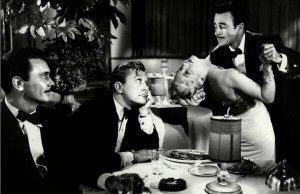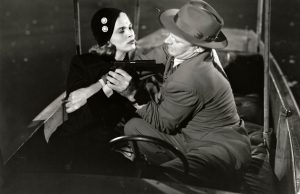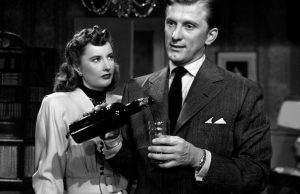I Walk Alone (1948)

Toronto Film Society presented I Walk Alone on Saturday, May 12, 2012 as part of Season 65 May Festival: The Dead Men Don’t Wear Plaid Weekend.
Title “I Walk Alone” is tight, hard-boiled melodrama, developed from Theodore Reeves’ short-lived stage play, “Beggars Are Coming to Town.” It punches over its melodramatics and has been given bright polish by Hal B. Wallis that should pay off. Names values are good and talent ably fits characters to give them sense of reality.
 A number of unusually tough sequences are spotted that will give ample satisfaction to the blood-thirsty. One, in particular, is bloody beating handed out to Burt Lancaster by a trio of bruisers who spare no punches. Another is the dark-street stalking and gore-tinged death meted out to Wendell Corey.
A number of unusually tough sequences are spotted that will give ample satisfaction to the blood-thirsty. One, in particular, is bloody beating handed out to Burt Lancaster by a trio of bruisers who spare no punches. Another is the dark-street stalking and gore-tinged death meted out to Wendell Corey.
Element of suspense is high, broken into only occasionally by cryptic bursts of brittle dialog, but even these scenes become clear as plot moves on. Byron Haskin earns a top credit with his strong direction, which has all the strength needed to unfold gutty action and other red-meat ingredients.
There’s a Rip Van Winkle angle to the plot wherein a gangster returns from 14 years in prison to find that his former cronies now wear the garb of respectability and are in such pseudo-legit rackets as used cars, night clubs, nylons, etc. Charles Schnee’s screenplay, from the adaptation by Robert Smith and John Bright, makes much of the basic story’s flavor, although letting dialog run away with a few scenes.
 Lancaster belts over his assignment as the former jailbird who returns from prison to find the parade has passed him by and that old friends have given him the double-cross. Melodrama develops as Lancaster plots to muscle in on Kirk Douglas prosperous nitery. He finds that old strongarm methods no longer work, rackets are now run through legal corporate setups. Tension hits hard as the rough-tough guys play it all out and windup is cleverly handled.
Lancaster belts over his assignment as the former jailbird who returns from prison to find the parade has passed him by and that old friends have given him the double-cross. Melodrama develops as Lancaster plots to muscle in on Kirk Douglas prosperous nitery. He finds that old strongarm methods no longer work, rackets are now run through legal corporate setups. Tension hits hard as the rough-tough guys play it all out and windup is cleverly handled.
Lizabeth Scott holds up her end capably as co-star, making role of nitery singer who falls for Lancaster after a cross from Douglas, believable. Douglas is a standout as the hood turned respectable and fighting a losing battle to hold his kingdom together against Lancaster’s assault. Wendell Corey impresses, as do Kristine Knox, George Rigaud, Marc Lawrence, Mike Mazurki and Mickey Knox.
Among potent values backing the production are Victor Young’s music score, the lensing by Leo Tover and art direction. Lizabeth Scott reprises the single tune, “Don’t Call It Love,” listenable cleffing by Ned Washington and Allie Wrubel.
VARIETY, Brog., December 13, 1947
When “I Walk Alone” first appeared, the term “film noir” was not being used, and it was regarded as another tough thriller—but even then it seemed well above average of its kind. Both it and 1949’s “Criss Cross” (also Lancaster, with Siodmak directing) seemed to benefit from coming late in the Noir cycle. Their characters were less stereotyped, and the stylistics had been refined. They suffered  critically from being lumped into an overall “tough crime film” cycle which took in the private eye films as well as the legitimate noirs. Now films like this can be seen as part of more specific noir categories, and probably appreciated a great deal more. “I Walk Alone” has no great reputation, although rather curiously—perhaps because of its powerful cast—it has become quite familiar on television. A big screen exposure is however long overdue.
critically from being lumped into an overall “tough crime film” cycle which took in the private eye films as well as the legitimate noirs. Now films like this can be seen as part of more specific noir categories, and probably appreciated a great deal more. “I Walk Alone” has no great reputation, although rather curiously—perhaps because of its powerful cast—it has become quite familiar on television. A big screen exposure is however long overdue.
A remarkable directorial debut from former cameraman Byron Haskin, it is tough and violent (one beating scene is especially vicious) yet it also has a warmth and mild sentimentality rare in noir; it is so well done that it is surprising than in an extremely varied career that took in Westerns and Sci-fi and the much under-rated “The Naked Jungle”, Haskin returned to Noir only in “Too Late For Tears” (which we ran a couple of years ago). Music is effectively used in conjuring up the past (especially Rodgers and Hart’s “Isn’t it Romantic?”) but not as obviously and as lazily as in so many current movies. While admitting that Kirk Douglas was too good an actor to be typed as a villain, he made such a great villain in earlier noirs like this one and “Out of the Past” that it’s a pity he didn’t play more slimy heavies in later years!
WILLIAM K. EVERSON, November 22, 1991
I WALK ALONE, screen play by Charles Schnee; adapted by Robert Smith and John Bright from the Theodore Reeves play “Beggars Are Coming to Town”; directed by Byron Haskin; produced by Hal Wallis for Paramount Pictures. At the Paramount.
It’s a mighty low class of people that you will meet in the Paramount’s “I Walk Alone”—and a mighty low grade of melodrama, if you want the honest truth—in spite of a very swanky setting and an air of great elegance. For the the people are mostly ex-gangsters, night club peddlers or social black sheep and the drama is of the vintage of gangster fiction of some twenty years ago.
True, the premise of the story, which originated with Theodore Reeves in a play done under the title of “Beggars Are Coming to Town,” is that an old-time bootleg mobster who has finished a long  stretch in jail can’t use the old-time tactics in muscling in on a welching ex-pal. The theory is that café business and corporation law in this new day are completely against the operation of any old-fashioned strong-arm stuff.
stretch in jail can’t use the old-time tactics in muscling in on a welching ex-pal. The theory is that café business and corporation law in this new day are completely against the operation of any old-fashioned strong-arm stuff.
But after establishing this premise in a lengthy and urbane way—that is, with lots of smooth palaver in the office of the owner of a swank cafe—and after revealing the would-be “muscler” as a fairly conventional dope, the story works right around to showing that the bruiser and the dope can still win out, provided he has the assistance and the confidence of a true-blue night-club girl. That, plus a plentitude of bravery and a couple of old stick-’em-up tricks.
Further, the general performance of this latter-day switch on “Broadway” is not in the category of distinguished theatrical work. Kirk Douglas is fairly effective as the pal who stayed clear and owns the joint, but Burt Lancaster plays the would-be “muscler” with the blank-faced aplomb of Tarzan. As the torch singer jilted by the former and thereafter inclined towards revenge, Lizabeth Scott has no more personality than a model in the window of a department store. Wendell Corey is wan as a spent mobster, while several others play tough guys viciously.
It is notable that the slant of sympathy is very strong toward the mug who did the “stretch,” as though he were some kind of martyr. Nice thing! Producer Hal Wallis should read the Code.
NEWYORK TIMES, by Bosley Crowther, January 22, 1948
Notes compiled by Caren Feldman










Leave a Reply